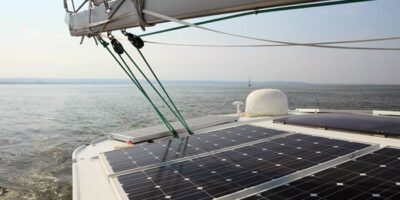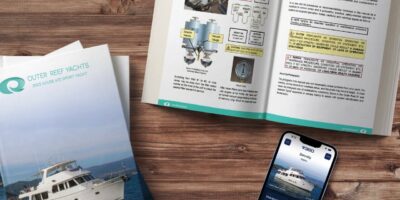Winterizing Your Boat Engine
Protect your boat's engine this winter! Follow our comprehensive checklist for outboard and inboard engines to prevent costly damage.
- January 29, 2024
When the temperature falls below freezing, if there is water inside your engine or gear case, the result can be a cracked block or housing and a repair bill that runs into the thousands. It is easy enough to prevent this unhappy circumstance by putting your boat’s engine to bed properly at the end of the boating season.
Prepare A Checklist
As with laying-up your boat for the season, it is essential not to miss a step. If your owner’s manual includes winterizing instructions, that is the procedure you should follow. In the absence of manufacturer’s instructions, here are two generic checklists for engine winterizing, one for outboards and one for inboards. Some steps on these lists may not apply to your particular engine.
Items you will need, other than your engine’s normal lubricants:
- An aerosol can of fogging oil
- A fuel stabilizer (gasoline engines) or a fuel biocide (diesel engines)
- For inboards, a gallon or two of non-toxic propylene glycol antifreeze
Winterize Your Outboard Engine
Freshwater flush
Use a flushing attachment or run the outboard in a tank filled with clean water.
Empty fuel lines and carburetors
While the engine is still running, disconnect the fuel line from the engine. When the engine dies, the fuel delivery components will be empty, preventing gums from forming in the stagnant gasoline and clogging lines and jets or injectors.
Fog the carburetor intake(s)
Before the engine runs out of fuel, spray fogging oil into the carburetor(s). Fogging oil is an anticorrosive that will protect the internal surfaces of the carburetor and the cylinders. Typically the engine will run rough just before it runs out of fuel. As that happens, give the carburetor(s) a heavier shot of fogging oil to make sure internal surfaces are fully coated.
Drain cooling passages
Disconnect the flush attachment or remove the motor from the flush tank. With the motor upright, let all water drain out of the pick-up. Open drain plugs (if any–see your owner’s manual) to empty the powerhead and intermediate housing. Crank the motor a couple of times by hand or “bump” it with the starter to empty the water pump. If the motor will be exposed to free.
Remove the spark plugs and spray fogging oil into the holes to coat the interior surfaces of the cylinders. Rotate the flywheel a few turns to spread the oil on the cylinder walls. While the plugs are out is the time to check them and regap or replace as required. Reinstall the spark plugs.
Lubricate linkages and the electric starter drive mechanism
Clean all pivots and visible gears and protect them for the winter with oil or grease, as specified in your owner’s manual.
Drain and refill gearcase
Use lubricant specified in your owner’s manual. Fill oil tank. This will prevent condensation from forming inside the tank.
Touch up damaged paint
Mist-coat powerhead with an anti-corrosion spray.
Drain fuel tank and supply lines
Starting your engine in the spring with old gasoline is an invitation to problems. Manage the last few weeks of your boating season to leave your fuel tank(s) close to empty, then drain the fuel that remains. Use it in your snow blower or burn it in your car, but leave gasoline tanks and lines empty.
If emptying the tank completely is not practical for your boat, then top it off to 95% full. This is particularly important since the introduction of alcohol into the gasoline supply. Gasoline with ethanol is subject to phase separation if water gets into the fuel, which it will surely do with a half-empty tank over the winter. Filling the tank limits the air space inside the tank and reduces the potential for internal condensation.
Stabilize the fuel
If you leave your tank full, dose it with an appropriate amount of gasoline stabilizer to combat the formation of passage-clogging gums.
Clean and liberally lubricate propeller shaft
The off season is the perfect time to have your prop(s) serviced. If the engine will be stored on the boat, take the prop(s) home to discourage theft.
Store upright
Laying the engine down risks water draining where it shouldn’t. An engine stand is easy enough to cobble together.
Winterize Your Inboard Engine
Change coolant — fresh-water cooled engines only
Coolant loses its anti-corrosion properties over time. Replacing it every year with a fresh 50-50 mix protects the inside of your engine.
Change oil in engine and transmission
First take the boat out for a ride to get the oil hot and contaminants in suspension. (This also distributes the fresh coolant throughout the engine.) Replace the oil filter.
Top-off fuel tanks and add biocide — diesel engines only
Keeping the tank full inhibits condensation, a serious problem for diesel engines. Treat the fresh fuel with a biocide to retard bacteria growth. A stabilizer is unnecessary unless you expect to run the engine during the winter since the paraffin that precipitates out will be reabsorbed by the fuel when warm weather returns.
Run engine out of fuel — gasoline engines only
Shut off the fuel supply and let the engine run until it stops.
Fog the intake — gasoline engines only
While the engine is running, remove the flame arrestor and spray fogging oil into the air intake. Give it an extra heavy shot just as the engine starves and dies.
Drain fuel tank and supply lines — gasoline engines only
If emptying the tank completely is not practical for your boat, then top it off to 95% full. Gasoline with ethanol is subject to phase separation if water gets into the fuel, which it will surely do with a half-empty tank over the winter. Filling the tank limits the air space inside the tank and reduces the potential for internal condensation. Dose the gasoline with an appropriate amount of stabilizer.
Flush raw-water circuit
If you have a fresh-water flush connector, use it. Otherwise, close the intake seacock and disconnect the hose on the outlet side of the raw-water pump. Disconnect the cooling-water discharge hose from the exhaust manifold or riser. Run fresh water into the discharge hose to back-flush raw-water passages and rinse out salt deposits. You can extend the disconnected pump hose outside the boat or let the bilge pump handle the flush discharge.
Protect raw-water passages — diesel engines only
The raw water circuit must be drained to prevent freezing, but air exposure promotes corrosion. Reconnect the water-pump outlet hose. Insert a funnel into the disconnected discharge hose and pour a 50-50 mix of propylene glycol antifreeze into the funnel until the hose will not accept more. Allow the mixture to remain inside the block for several minutes, then open all raw-water drain plugs and drain the engine. This treatment leaves behind a layer of corrosion protection on the water-jacket, and it freeze-protects any water that might be harbored in low spots inside the engine.
This treatment is also applicable to protecting the heat exchanger on a fresh-water cooled engine.
Remove raw-water impeller
Antifreeze swells some rubbers, so rinse the extracted impeller as a precaution. Some grease the impeller and reinstall it. My preference is to leave it out until spring so the vanes don’t take a set.
Fog cylinders — gasoline engines only
Remove the spark plugs and spray fogging oil into the holes. “Bump” the starter to spread the oil on the cylinder walls. Regap or replace plugs, as required, and reinstall.
Fog intake — diesel engines only
Spray fogging oil into the intake manifold and turn the engine over slowly by hand to draw the oil into the cylinders and spread it. Do not use the starter, even with the stop control pulled out; the engine can start on the fogging oil.
Drain muffler canister
The less moisture the engine is exposed to, the less corrosion will occur.
Degrease, derust, touch-up
Maintain all painted surfaces to keep corrosion at bay.
Grease control cables
Extract control cables from their housings and coat them with grease. If you cannot remove them, tape an oil-filled bag tightly around the high end of the housing; the oil will work its way down the cable. Lubricate linkages and pivots.
Coat unpainted parts with an anti-corrosion spray
As with laying-up your boat for the season, it is essential not to miss a step. If your owner’s manual includes winterizing instructions, that is the procedure you should follow. In the absence of manufacturer’s instructions, here are two generic checklists for engine winterizing, one for outboards and one for inboards. Some steps on these lists may not apply to your particular engine.
Seal all engine and tank openings
Keep moist air from getting inside your engine and tanks. Seal air inlets, crankcase and transmission breathers, exhaust outlets, and tank vents. Fabricate caps from plastic containers and tape them in place with plastic tape to create an airtight seal. Try to do this on a dry day so you do not seal in moist air. List all openings sealed this way so you will remember to open them in the spring. As a rule, you should not completely seal a fuel tank vent, so if you cap it to retard moisture transfer, puncture the cap to avoid pressure build-up in the tank.
Tighten stuffing box
If the boat will be stored in the water, tighten the stuffing box to eliminate all dripping. Tag it to remind you to readjust it in the spring.
Stern Drive
A stern drive is, in principle, an inboard engine married to an outboard drive system. If your boat has a stern drive you will need to follow the inboard list for protecting the engine, but add to that several items from the outboard list for protecting the lower end. An additional requirement is filling the drive shaft housing with the appropriate lubricant.
Remember that a stern drive needs to be in the full-down position for draining the water passages and for checking or adding gear lube. Store it in the down position.
Don Casey
Contributor, BoatUS Magazine
About Vessel Vanguard
Vessel Vanguard is a leading marine safety and maintenance management software provider dedicated to revolutionizing the maritime industry. With a commitment to innovation and excellence, Vessel Vanguard delivers cutting-edge solutions to streamline operations and enhance vessel performance and safety.
Latest Industry Insights

Embracing E-Boating Efficiencies

Boat Fuel Systems

The Future of Boats & Boating

Yacht Navigation Light Inspection
View All of Our Industry Insights
Navigate maritime with the latest news, practical how-to guides, insightful analyses and more.
